Cranberries are a staple in many kitchens, especially around the holidays.
Yet, sometimes you reach for that bag in the fridge, and it’s just not there.
What do you do? No need to scrap your plans or make a last-minute grocery run.
There’s a whole lineup of substitutes that can save your dish and maybe even amp up the flavor.
We’ve got the inside scoop on the five best swaps for cranberries.
Some of these alternatives might surprise you, and others might already be in your pantry.
Together, we’re going to keep your cooking game strong, no cranberries required.
Excited? You should be, because these substitutes are not only easy to find but could also become your new favorites.
What are Cranberries?

Cranberries are a type of berry, typically red or pink.
They are small, round fruit and are grown in moist climates.
Cranberries are often eaten around the holidays but can be enjoyed all year long.
They are known for their tart flavor but can also taste sweet depending on the added ingredients they are prepared with.
Cranberries can be eaten raw or cooked into different foods.
They are very versatile and can be baked into bread, muffins, cakes, and other desserts.
These tart red berries are also often used in sauces or dressings for beef or pork.
If the cranberries are very ripe, they can be blended with fruit juices like orange or pineapple to make delectable drinks.
They can also be used topping yogurt and oatmeal for a more tart taste.
Cranberry juice is another popular beverage that is made from this berry.
If the juice is sweetened with sugar, it can be enjoyed like a traditional soda or fruit drink.
Cranberry juice is often used as an ingredient in cocktails because of its tart flavor.
The 5 Best Substitutes for Cranberries
Cranberries are a tart and vibrant fruit commonly used in various recipes. However, if you don’t have cranberries on hand or prefer alternatives, there are several substitutes that can provide similar characteristics and flavors. In this guide, we will explore the top 5 substitutes for cranberries, comparing their key characteristics and providing the proper ratios to ensure the best results in your recipes.
| Substitute | Key Characteristics | Proper Ratio |
|---|---|---|
| Raspberries | Tart, slightly sweet, and similar texture to cranberries | Replace 1 cup of cranberries with 1 cup of raspberries |
| Pomegranate | Sweet, tangy, and provides a burst of flavor | Replace 1 cup of cranberries with 1 cup of pomegranate arils or juice |
| Currant | Tart, slightly bitter, and similar in size to cranberries | Replace 1 cup of cranberries with 1 cup of currants |
| Puckerberry | Tart and sour, provides a similar level of acidity as cranberries | Replace 1 cup of cranberries with 1 cup of puckerberries (serviceberry) |
| Strawberries | Sweet, juicy, and offers a milder flavor compared to cranberries | Replace 1 cup of cranberries with 1 cup of sliced strawberries |
Now let’s dive into each substitute in more detail:
1 – Raspberries
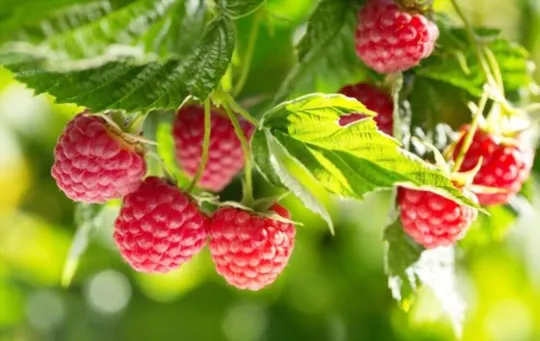
Raspberries are a red berry that is typically eaten fresh.
They can be found in most grocery stores and local farmer’s markets during the summer months, but some countries also grow them in greenhouses where they can produce raspberries all year long.
These berries contain antioxidants that can help protect your body from free radicals.
So, adding them to your diet is a good way to stay healthy.
Raspberries are also incredibly sweet because they have high amounts of sugar – usually between 10 and 12%.
This means that eating them can boost the flavor of meals, but be careful not to go overboard when adding them in.
Raspberries are perfect for pies or any baking recipe that calls for cranberries because of their tart flavor.
- Key Characteristics: Raspberries have a tart and slightly sweet flavor, similar to cranberries. They also share a similar texture, making them an excellent substitute.
- Proper Ratio: Replace 1 cup of cranberries with 1 cup of raspberries. Adjust the quantity based on your desired level of tartness.
2 – Pomegranate
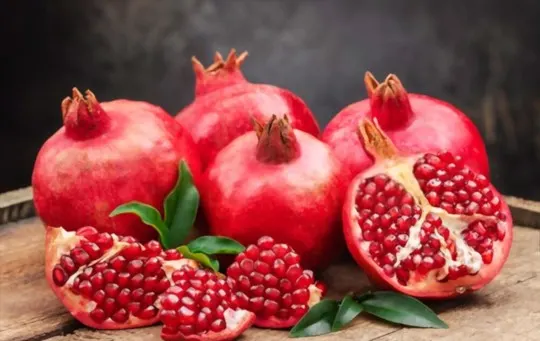
Pomegranates are red fruits that are typically eaten fresh.
They can be difficult to cut because of their shell-like skin wrapped around the seeds.
This fruit has a sweet and tart flavor profile, but it’s important to note that pomegranate juice can taste very bitter if you don’t use enough sugar when making your drink.
The seeds themselves are very tart, but they can also taste sweet.
This is because pomegranate juice can be produced – one with the flesh (arils) and one without (seeds only).
Pomegranate arils contain both sugar and natural calories, but these should be monitored carefully if you plan on incorporating them into your diet.
- Key Characteristics: Pomegranate offers a sweet and tangy flavor that can provide a burst of flavor to your recipes, similar to cranberries.
- Proper Ratio: Replace 1 cup of cranberries with 1 cup of pomegranate arils or juice. Adjust the quantity based on your desired level of sweetness and tanginess.
3 – Currant
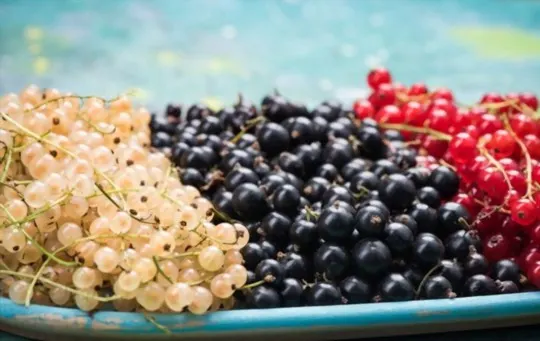
Currants are dark red fruits that come from shrubs.
They can be found in almost all regions of the northern hemisphere and the southern hemisphere as well.
They have a sweet taste that is lighter than other berries – while raspberries have a sugar content of around 10 to 12%, currants contain just 3 to 4% of sugar.
However, they have a much tarter flavor because they are typically used to make jam or jellies.
Although these fruits may be hard to find, they can complement savory dishes that call for cranberries.
For example, currants might go well with chicken for a unique twist of flavors during Thanksgiving dinner.
The leaves of the currant plant are rich in tannins which have been used for centuries to make dyes.
- Key Characteristics: Currants have a tart and slightly bitter taste, similar in size to cranberries. They can be a suitable substitute in recipes where cranberries are used.
- Proper Ratio: Replace 1 cup of cranberries with 1 cup of currants. Adjust the quantity based on your desired level of tartness.
4 – Puckerberry
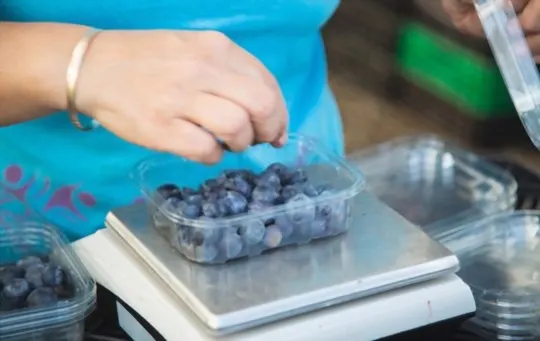
Puckerberries have a flavor that is very similar to sour candy.
This pale red berry usually contains around 10% sugar, but it has several times more citric acid than lemons or limes.
It should be noted that puckerberries are ripened gooseberries.
They are tart and bitter, making them perfect for pies, tarts, jams, and jellies.
They are also commonly used to make wine because they can increase the acid level.
Puckerberry juice made from this fruit is incredibly tart, making it perfect for cocktails or as an ingredient in baking recipes requiring cranberries.
- Key Characteristics: Puckerberries, also known as serviceberries, provide a similar level of tartness and acidity as cranberries. They can add a tangy flavor to your dishes.
- Proper Ratio: Replace 1 cup of cranberries with 1 cup of puckerberries (serviceberries). Adjust the quantity based on your desired level of tartness.
5 – Strawberries
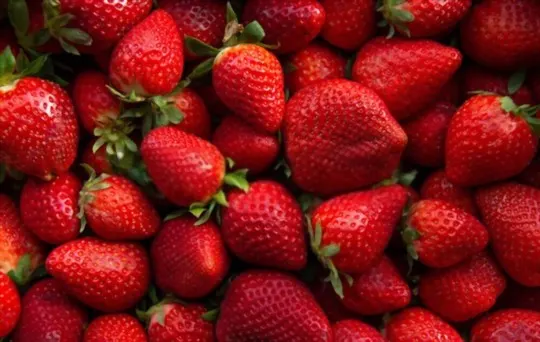
Strawberries are a delicious fruit that can be eaten fresh or as a dessert.
However, they make an excellent substitute for cranberries because they have high amounts of pectin, also found in cranberries.
Pectin is a carbohydrate that helps thicken jams and jellies – this means that strawberry jam will taste incredibly close to the flavor of cranberry jam.
Even better, strawberries are much sweeter, which means that you can use less sugar when making your desserts.
Although strawberries may be sweet due to their high sugar content, they also have water.
This means that if you’re making strawberry jelly or jams, make sure to use plenty of sugar to balance out the tart flavor.
- Key Characteristics: Strawberries are sweet, juicy, and offer a milder flavor compared to cranberries. They can add a touch of sweetness and color to your recipes.
- Proper Ratio: Replace 1 cup of cranberries with 1 cup of sliced strawberries. Adjust the quantity based on your desired level of sweetness.
Conclusion
Cranberries are very tart, which makes them perfect for baking.
However, they can be difficult to come by – you may have to go to specialty stores or markets to find the best selection.
Luckily, several other fruits make excellent substitutes for cranberry flavor.
Depending on your recipe, you can use one of these substitutes or a combination of two or more fruits.
For example, you can use black currants and raspberries in the same tart for a unique and flavorful twist on cranberry flavor.
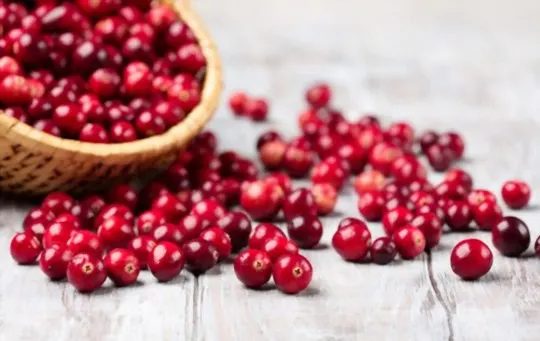
The 5 Best Substitutes for Cranberries
Ingredients
- Raspberries
- Pomegranate
- Currant
- Puckerberry
- Strawberries
Instructions
- Pick your favorite substitute from the list above.
- Follow cooking directions for your selected substitute with the proper ratio of ingredients.

Andrew Gray is a seasoned food writer and blogger with a wealth of experience in the restaurant and catering industries. With a passion for all things delicious, Andrew has honed his culinary expertise through his work as a personal chef and caterer.
His love for food led him to venture into food writing, where he has contributed to various online publications, sharing his knowledge and insights on the culinary world. As the proud owner of AmericasRestaurant.com, Andrew covers a wide range of topics, including recipes, restaurant reviews, product recommendations, and culinary tips.
Through his website, he aims to inspire and educate fellow food enthusiasts, offering a comprehensive resource for all things food-related.

Leave a comment